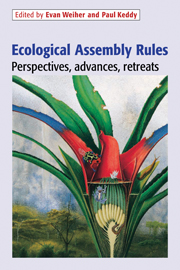Book contents
- Frontmatter
- Contents
- List of Contributors
- Introduction: The scope and goals of research on assembly rules
- Part I The search for meaningful patterns in species assemblages
- 1 The genesis and development of guild assembly rules
- 2 Ruling out a community assembly rule: the method of favored states
- 3 Community structure and assembly rules: confronting conceptual and statistical issues with data on desert rodents
- 4 Introduced avifaunas as natural experiments in community assembly
- 5 Assembly rules in plant communities
- 6 Assembly rules at different scales in plant and bird communities
- 7 Impact of language, history and choice of system on the study of assembly rules
- Part II Other perspectives on community assembly
- Index
3 - Community structure and assembly rules: confronting conceptual and statistical issues with data on desert rodents
Published online by Cambridge University Press: 04 September 2009
- Frontmatter
- Contents
- List of Contributors
- Introduction: The scope and goals of research on assembly rules
- Part I The search for meaningful patterns in species assemblages
- 1 The genesis and development of guild assembly rules
- 2 Ruling out a community assembly rule: the method of favored states
- 3 Community structure and assembly rules: confronting conceptual and statistical issues with data on desert rodents
- 4 Introduced avifaunas as natural experiments in community assembly
- 5 Assembly rules in plant communities
- 6 Assembly rules at different scales in plant and bird communities
- 7 Impact of language, history and choice of system on the study of assembly rules
- Part II Other perspectives on community assembly
- Index
Summary
Introduction
Two main themes have dominated empirical research in community ecology for the last several decades. On the one hand, the enormously successful experiments of British plant ecologists and of intertidal ecologists such as Connell (1961a, b) and Paine (1966) stimulated many ecologists to perform controlled, replicated, manipulative field studies to investigate direct and indirect interactions. On the other hand, the insightful observations of Hutchinson (1957) and MacArthur (1958) stimulated many other ecologists to explore the relationships between patterns of community organization and the mechanistic processes that produce them. These two approaches have tended to diverge in the kinds of organisms and the spatial and temporal scales studied. The experimentalists tended to work with terrestrial plants, freshwater fishes and amphibians, and intertidal marine organisms, to manipulate on small spatial scales, and to study ongoing, proximate ecological processes. In contrast, those studying patterns of community organization tended to study terrestrial reptiles, birds, and mammals, to do comparative studies over geographic spatial scales, and to be concerned with evolutionary, as well as ecological, processes and timescales. Most studies of community-level patterns and processes have focused on two phenomena: the organization of food webs (e.g., Cohen et al., 1993; Polis & Strong, 1996; papers in Special Feature section of Ecology 69, pp. 1647–1676) and the structure of ‘guilds’ (sets of functionally similar and closely related species; e.g., Cody & Diamond, 1975; Diamond & Case, 1986; Simberloff & Dayan, 1991).
- Type
- Chapter
- Information
- Ecological Assembly RulesPerspectives, Advances, Retreats, pp. 75 - 107Publisher: Cambridge University PressPrint publication year: 1999
- 20
- Cited by



